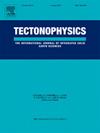Reconciling high-resolution strain rate of continental China from GNSS data with the spherical spline interpolation
IF 2.7
3区 地球科学
Q2 GEOCHEMISTRY & GEOPHYSICS
引用次数: 0
Abstract
In this study, we propose a new generation of high-resolution strain rate models for present-day continental China. The models were developed using up-to-date Global Navigation Satellite System (GNSS) observation data from 3571 stations. A spherical spline method was used to reconcile the sparsely distributed GNSS velocity data into an integrated regional spherical coordinate frame. The model simultaneously calculates the strain rate with an ideal order of continuity while preserving the discontinuity between tectonically active major fault zones and deforming blocks. Inspection standards were used to assess the validity and resolution of the proposed model. The spherical spline method was deliberately examined and the fitting to the GNSS velocity data was justified to illustrate the inspection standards. A spherical harmonic model was also constructed for the resolution tests. By introducing test criteria, the spherical spline method can reproduce the velocity and strain-rate fields in substantial order, indicating that the developed method has a high level of applicability for estimating the strain rate in active tectonic regions and for global models. Finally, the spherical spline method was used with the GNSS velocity data to calculate the strain-rate fields in continental China. The correlation between the seismic mechanisms and the strain-rate field of earthquakes was also assessed. The results indicate that the proposed high-resolution strain rate model could be used to explain the deformation and evolution models of continental China.
中国大陆GNSS数据高分辨率应变率与球面样条插值的调和
在这项研究中,我们提出了一个新一代的高分辨率应变速率模型,用于当今中国大陆。这些模型是利用3571个站点最新的全球导航卫星系统(GNSS)观测数据开发的。采用球面样条法将稀疏分布的GNSS速度数据协调到一个完整的区域球面坐标系中。该模型在保持构造活动大断裂带与变形块体之间的不连续性的同时,以理想的连续顺序计算应变速率。使用检验标准来评估所提出模型的有效性和分辨率。对球面样条法进行了仔细的检验,并对其与GNSS速度数据的拟合进行了论证,以说明检验标准。建立了球谐模型进行分辨率测试。通过引入试验准则,球面样条法能较好地再现速度场和应变率场,表明该方法对活动性构造区应变率估计和全球模型具有较高的适用性。最后,利用球面样条法结合GNSS速度数据计算了中国大陆的应变速率场。分析了地震机制与地震应变率场之间的关系。结果表明,所建立的高分辨率应变速率模型可用于解释中国大陆的变形和演化模式。
本文章由计算机程序翻译,如有差异,请以英文原文为准。
求助全文
约1分钟内获得全文
求助全文
来源期刊

Tectonophysics
地学-地球化学与地球物理
CiteScore
4.90
自引率
6.90%
发文量
300
审稿时长
6 months
期刊介绍:
The prime focus of Tectonophysics will be high-impact original research and reviews in the fields of kinematics, structure, composition, and dynamics of the solid arth at all scales. Tectonophysics particularly encourages submission of papers based on the integration of a multitude of geophysical, geological, geochemical, geodynamic, and geotectonic methods
 求助内容:
求助内容: 应助结果提醒方式:
应助结果提醒方式:


